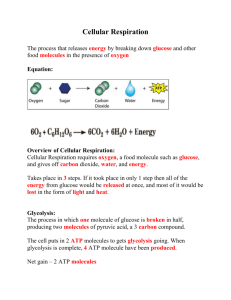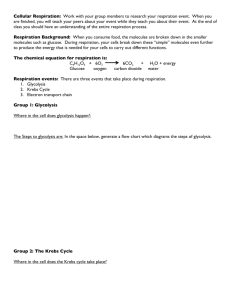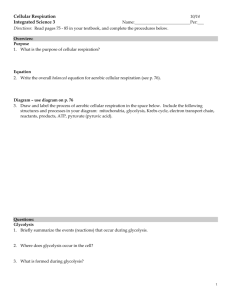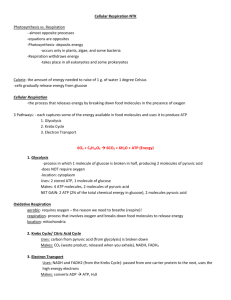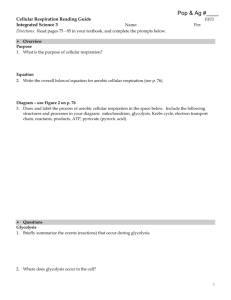Cellular Respiration Animation Notes KEY - High School Biology
advertisement
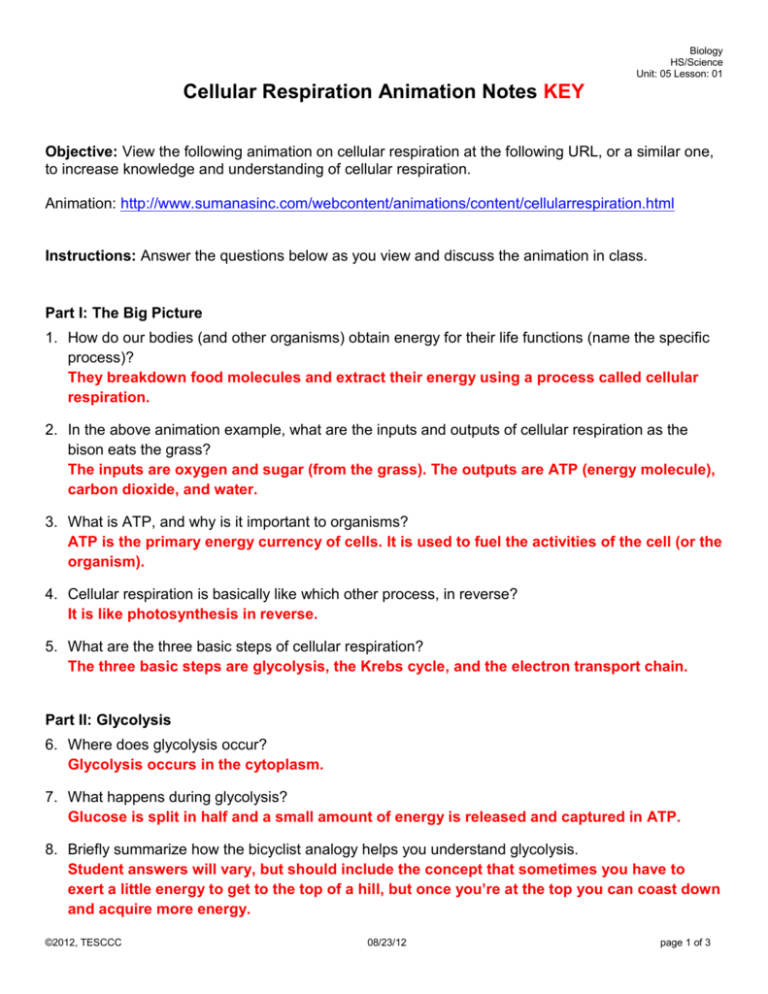
Biology HS/Science Unit: 05 Lesson: 01 Cellular Respiration Animation Notes KEY Objective: View the following animation on cellular respiration at the following URL, or a similar one, to increase knowledge and understanding of cellular respiration. Animation: http://www.sumanasinc.com/webcontent/animations/content/cellularrespiration.html Instructions: Answer the questions below as you view and discuss the animation in class. Part I: The Big Picture 1. How do our bodies (and other organisms) obtain energy for their life functions (name the specific process)? They breakdown food molecules and extract their energy using a process called cellular respiration. 2. In the above animation example, what are the inputs and outputs of cellular respiration as the bison eats the grass? The inputs are oxygen and sugar (from the grass). The outputs are ATP (energy molecule), carbon dioxide, and water. 3. What is ATP, and why is it important to organisms? ATP is the primary energy currency of cells. It is used to fuel the activities of the cell (or the organism). 4. Cellular respiration is basically like which other process, in reverse? It is like photosynthesis in reverse. 5. What are the three basic steps of cellular respiration? The three basic steps are glycolysis, the Krebs cycle, and the electron transport chain. Part II: Glycolysis 6. Where does glycolysis occur? Glycolysis occurs in the cytoplasm. 7. What happens during glycolysis? Glucose is split in half and a small amount of energy is released and captured in ATP. 8. Briefly summarize how the bicyclist analogy helps you understand glycolysis. Student answers will vary, but should include the concept that sometimes you have to exert a little energy to get to the top of a hill, but once you’re at the top you can coast down and acquire more energy. ©2012, TESCCC 08/23/12 page 1 of 3 Biology HS/Science Unit: 05 Lesson: 01 9. Summarize the process of glycolysis. Two ATP molecules are added to a glucose molecule. The glucose now has two extra phosphates, making it unstable and causing it to split in half. Then, three reactions yield energy. First, the two glucose halves both attach to a high-energy phosphate group. The glucose then donates high-energy electrons and hydrogen ions (protons) to electron carries called NAD+. This results in NADH molecules that are high-energy electron carriers. These NADH molecules are used later in cellular respiration. Then, glycolysis continues and more bonds between the glucose molecules are broken. Energy is recaptured by attaching phosphate groups to molecules of ADP, which creates energy-rich ATP. In addition, two water molecules are produced. Finally, two more ADP molecules take the last two phosphate groups and make two more ATP molecules. The glucose is now two pyruvate molecules. 10. What are the products of glycolysis? The products are two molecules of pyruvate, two molecules of water, two NADH molecules and four ATP molecules. 11. What is the net energy yield at the end of glycolysis? The net yield is two NADH molecules and two ATP molecules because two ATP molecules were required to start glycolysis. There is also energy remaining in the pyruvate molecules. Part III: The Krebs Cycle 12. Where does the Krebs cycle take place? It takes place in the mitochondria of cells. 13. In the first series of reactions for the Krebs cycle, what are the products from the original two pyruvate molecules? The products are two carbon dioxide molecules, two NADH molecules, and two Acetyl CoA molecules. 14. What is the first outcome of the Krebs cycle? The first outcome is the production of a molecule with six carbon atoms. 15. What is created (what are the products) during the second outcome of the Krebs cycle? The products during the second part of the Krebs cycle are two NADH molecules and two carbon dioxide molecules. 16. What are the three products of the third phase of the Krebs cycle? The three products are one ATP molecule, one NADH molecule, and one FADH2 molecule. 17. What happens at the very end of the Krebs cycle (the final outcome)? The cycle’s starting molecule reforms, and then the cycle repeats one more time. ©2012, TESCCC 08/23/12 page 2 of 3 Biology HS/Science Unit: 05 Lesson: 01 Part IV: The Electron Transport Chain 18. NADH and FADH2 enter the electron transport chain after being created during the Krebs cycle. What is their role in the electron transport chain, and what happens after they fulfill their role? They donate their extra electrons to the electron transport chain and go back to their original state, NAD+ and FAD. Then, they go back to participate in the Krebs cycle again. 19. What does the electron transport chain create? A large number of ATP molecules 20. What is required for the electron transport chain to operate? It must have oxygen to function. 21. What will happen if oxygen is no longer available? Both the electron transport chain and Krebs cycle will shut down. 22. Where does the electron transport chain occur? It occurs in the mitochondria of cells. 23. What drives the protons (H+ ions) across the mitochondrial membrane to form ATP? The concentration gradient (more H+ ions on one side causes them to cross the membrane). ©2012, TESCCC 08/23/12 page 3 of 3



